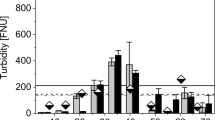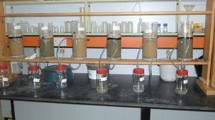Abstract
Washing-down parlours and standing areas, following milking on dairy farms, produce dairy soiled water (DSW) that contains variable concentrations of nutrients. Aerobic woodchip filters can remove organic matter, nutrients and suspended solids (SS) in DSW, but the effluent exiting the filters may have to be further treated before it is suitable for re-use for washing yard areas. The performance of a single-layer sand filter (SF) and a stratified SF, loaded at 20 L m−2 day−1, to polish effluent from a woodchip filter was investigated over 82 days. Average influent unfiltered chemical oxygen demand (CODT), total nitrogen (TN), ammonium–N (NH4–N), ortho-phosphorus (PO4–P) and SS concentrations of 1,991 ± 296, 163 ± 40, 42.3 ± 16.9, 27.2 ± 6.9 and 84 ± 30 mg L−1 were recorded. The single-layer SF decreased the influent concentration of CODT, TN, NH4–N, PO4–P and SS by 39, 36, 34, 58 and 52 %, respectively. Influent concentrations of CODT, TNT, NH4–N, PO4–P and SS were decreased by 56, 57, 41, 74 and 62 % in the stratified SF. The single-layer SF and the stratified SF were capable of reducing the influent concentration of total coliforms by 96 and 95 %, respectively. Although a limited amount of biomass accumulated in the uppermost layers of both SFs, organic and particulate matter deposition within both filters affected rates of nitrification. Both types of SFs produced final water quality in excess of the standards for re-use in the washing of milking parlours.





Similar content being viewed by others
References
APHA-AWWA-WEF. (1995). Standard methods for the examination of water and wastewater (19th ed.). Washington, USA: American Public Health Association.
Bahgat, M., Dewedar, A., & Zayed, A. (1999). Sand-filters used for wastewater treatment: buildup and distribution of microorganisms. Water Research, 33, 1949–1955.
Ball, J. L., & Denn, G. D. (1997) Design of recirculating sand filters using a standardized methodology. In: M.S. Bedinger, A.I. Johnson, and J.S. Fleming (eds). Site characterisation and design of on-site septic systems, ASTM STP 898. American Society for Testing and Materials. West Conshohocken, PA, USA, pp. 191–206.
Bouwer, E. J., Rijnaarts, H. H. M., Cunningham, A. B., & Gerlach, R. (2000). Biofilms in porous media. In J. D. Bryers (Ed.), Biofilms II: process analysis and applications (pp. 123–158). New York: Wiley.
BS 1377-3 (1990) Part 4. Determination by mass-loss on ignition. British standard method of test for soils for civil engineering purposes. Chemical and electro-chemical tests.
BS 1377-5 (1990) Part 5. Determination of permeability by the constant-head method. British standard method of test for soils for civil engineering purposes. Compressabilty, permeability and durability tests.
Campos, L. C., Su, M. F. J., Graham, N. J. D., & Smith, S. R. (2002). Biomass development in slow sand filters. Water Research, 36, 4543–4551.
Craig, R.F. (1997) Soil mechanics. 6th edition. (485 pp.) E & FN Spon, London.
EC (1980) Council Directive of 15 July 1980 relating to the quality of water intended for human consumption (80/778/EEC).
Gill, L. W., O'Suilleabhain, C., Misstear, B. D. R., & Johnston, P. M. (2009). Comparison of stratified sand filters and percolation trenches for on-site wastewater treatment. Journal of Environmental Engineering, 135, 8–16.
Gross, M., & Mitchell, D. (1985) Biological virus removal from household septic tank effluent. Proceedings of the fourth national symposium on individual and small community sewage systems. New Orleans, LA. December 10-11, ASAE Publication 07-85, 1985, pp. 295–304.
Healy, M. G., Rodgers, M., & Mulqueen, J. (2006). Denitrification of a nitrate-rich synthetic wastewater using various wood-based media materials. Journal of Environmental Science and Health - Part A Toxic/Hazardous Substances and Environmental Engineering, 41, 779–788.
Healy, M. G., Burke, P., & Rodgers, M. (2010). The use of laboratory sand, soil and crushed-glass filter columns for polishing domestic-strength synthetic wastewater that has undergone secondary treatment. Journal of Environmental Science and Health, Part A: Toxic/Hazardous Substances and Environmental Engineering, 45, 1635–1641.
Healy, M. G., Rodgers, M., & Burke, P. (2011). Quantification of biofilm build-up in filters when intermittently loaded with low-strength synthetic wastewater. Desalination, 271(1–3), 105–110.
IMQCS and Teagasc. (2004). Recommendations for the installation and testing of milking machines. Dublin, Ireland: Irish Milk Quality Co-operative Society.
Knudsen, M. T., Kristensen, I. B. S., Berntsen, J., Petersen, B. M., & Kristensen, E. S. (2006). Estimated N leaching losses for organic and conventional farming in Denmark. Journal of Agricultural Science, 144, 135–149.
Leverenz, H. L., Tchobanoglous, G., & Darby, J. L. (2009). Clogging in intermittently dosed sand filters used for wastewater treatment. Water Research, 43, 695–705.
Loomis, G., & Dow, D. (1999) Guidelines for the design and use of sand filters in critical resource areas. Rhode Island Department of Environmental Management, NY, USA.
Martínez-Suller, L., Provolo, G., Carton, O. T., Brennan, D., Kirwan, L., & Richards, K. G. (2010). The composition of dirty water on dairy farms in Ireland. Irish Journal of Agricultural and Food Research, 49, 67–80.
McBride, M. B. (2000). Chemisorption and precipitation reactions. In M. E. Sumner (Ed.), Handbook of soil science (pp. B-265–B-302). Boca Raton: CRC Press.
Nakhla, G., & Farooq, S. (2003). Simultaneous nitrification–denitrification in slow sand filters. Journal of Hazardous Materials, 96, 291–303.
Nichols, D. J., Wolf, D. C., Gross, M. A., & Rutledge, E. M. (1997). Renovation of septic effluent in a stratified sand filter. ASTM Special Technical Publication, 1324, 235–247.
Nie, J. Y., Zhu, N. W., Zhao, K., & Hu, Y. H. (2011). Analysis of the bacterial community changes in soil for septic tank effluent treatment in response to bio-clogging. Water Science and Technology, 63(7), 1412–1417.
Prochaska, C. A., & Zouboulis, A. I. (2003). Performance of intermittently operated sand filters: a comparable study, treating wastewaters of different origins. Water, Air, and Soil Pollution, 147, 367–388.
Regan, J. T., Rodgers, M., Healy, M. G., Kirwan, L., & Fenton, O. (2010). Determining phosphorus and sediment release rates from five Irish tillage soils. Journal of Environmental Quality, 39, 185–192.
Rodgers, M., Mulqueen, J., & Healy, M. G. (2004). Surface clogging in an intermittent stratified sand filter. Soil Science Society of America Journal, 68, 1827–1832.
Rodgers, M., Healy, M. G., & Mulqueen, J. (2005). Organic carbon removal and nitrification of high strength wastewaters using stratified sand filters. Water Research, 39, 3279–3286.
Rolland, L., Molle, P., Liénard, A., Bouteldja, F., & Grasmick, A. (2009). Influence of the physical and mechanical characteristics of sands on the hydraulic and biological behaviors of sand filters. Desalination, 248, 998–1007.
Ruane, E. M., Murphy, P. N. C., Clifford, E., O'Reilly, E., French, P., & Rodgers, M. (2011a). Performance of a woodchip filter to treat dairy soiled water. Journal of Environmental Management, 95(1), 49–55.
Ruane, E. M., Murphy, P. N. C., Healy, M. G., French, P., & Rodgers, M. (2011b). On-farm treatment of dairy soiled water using aerobic woodchip filters. Water Research, 45, 6668–6676.
SAS Institute (2004) SAS online. Version 9.1. SAS Inst., Cary, NC.
Schwager, A., & Boller, M. (1997). Transport phenomena in intermittent filters. Water Science and Technology, 35(6), 13–20.
Statutory Instrument No. 610 of 2010. European communities (good agricultural practice for protection of waters) regulations 2010. http://www.irishstatutebook.ie/2010/en/si/0610.html. Accessed July 30, 2013.
Stevik, T. K., Aa, K., Ausland, G., & Hanssen, J. F. (2004). Retention and removal of pathogenic bacteria in wastewater percolating through porous media: a review. Water Research, 38, 1355–1367.
Torrens, A., Molle, P., Boutin, C., & Salgot, M. (2009). Impact of design and operation variables on the performance of vertical-flow constructed wetlands and intermittent sand filters treating pond effluent. Water Research, 43, 1851–1858.
US Environmental Protection Agency (1980). Design Manual: Onsite Wastewater Treatment and Disposal Systems. EPA Report no. 625/1–80–012. Cincinnati, OH.
Acknowledgements
The authors are grateful to Teagasc for the award of a Walsh Fellowship to the first author and for financial support provided by the Research Stimulus Fund (Department of Agriculture, Fisheries and Food). The authors appreciate the technical help of J. Kennelly and D. Minogue (Teagasc).
Author information
Authors and Affiliations
Corresponding author
Rights and permissions
About this article
Cite this article
Ruane, E.M., Murphy, P.N.C., French, P. et al. Comparison of a Stratified and a Single-Layer Laboratory Sand Filter to Treat Dairy Soiled Water from a Farm-Scale Woodchip Filter. Water Air Soil Pollut 225, 1915 (2014). https://doi.org/10.1007/s11270-014-1915-z
Received:
Accepted:
Published:
DOI: https://doi.org/10.1007/s11270-014-1915-z




